 Ban Bo Luang lies in far western Nan province, only a dozen kilometres from the Lao border. The town is nestled in an incredibly picturesque valley with forested mountains on either side and is inhabited by three ethnic groups: Htin, Lua and northern Thai. The town is colloquially known as Ban Bo Klua (Salt Well Village) because the town's well produces extremely salty water. You'd think this would be horrible luck (in fact there are freshwater wells and a beautiful stream there as well), but from this well the locals have been extracting ‘mountain salt’ for an estimated 300 years.
Ban Bo Luang lies in far western Nan province, only a dozen kilometres from the Lao border. The town is nestled in an incredibly picturesque valley with forested mountains on either side and is inhabited by three ethnic groups: Htin, Lua and northern Thai. The town is colloquially known as Ban Bo Klua (Salt Well Village) because the town's well produces extremely salty water. You'd think this would be horrible luck (in fact there are freshwater wells and a beautiful stream there as well), but from this well the locals have been extracting ‘mountain salt’ for an estimated 300 years.
Salt, as some of you probably know, was previously a seriously valuable commodity, particularly for those with no access to the sea. It’s said that caravans from remote corners of China would stop by Ban Bo Luang to load up on the ‘white gold’ before returning home. Although just about everybody around the world has access to salt nowadays, little has changed at Ban Bo Luang, and they're still collecting salt as they've done for centuries now.
The salty water originates from a couple deep wells in the centre of the town:

The water is pumped from these wells into several rough huts that have rows of large earthen 'stoves':

The water is then boiled for about three hours until much of the liquid evaporates and crystals start to form. The salt is then scooped into bamboo baskets to drain:

The guy pictured here is a native of Ban Bo Klua and has been doing this job much of his life:

When it's his shift he actually sleeps in the smoky hut, waking every few hours to refuel the fires, scoop salt and refill water. The salt is sold in bags directly from the village, delivered elsewhere around Nan, and is now even being purified at the local hospital and used in different dermatological treatments. I reckon they should package it and slap on a label that says 'Artisan Hand-Collected Htin Mountain Salt' and sell it to people New York City for $8 a bag.












 Phayao, a small town that most Thais aren’t even aware exists, turned about to be one of the more pleasant destinations of my trip. The town’s setting at the edge of a vast swamp is a lot more interesting than it sounds, and the city also had some very tasty food
Phayao, a small town that most Thais aren’t even aware exists, turned about to be one of the more pleasant destinations of my trip. The town’s setting at the edge of a vast swamp is a lot more interesting than it sounds, and the city also had some very tasty food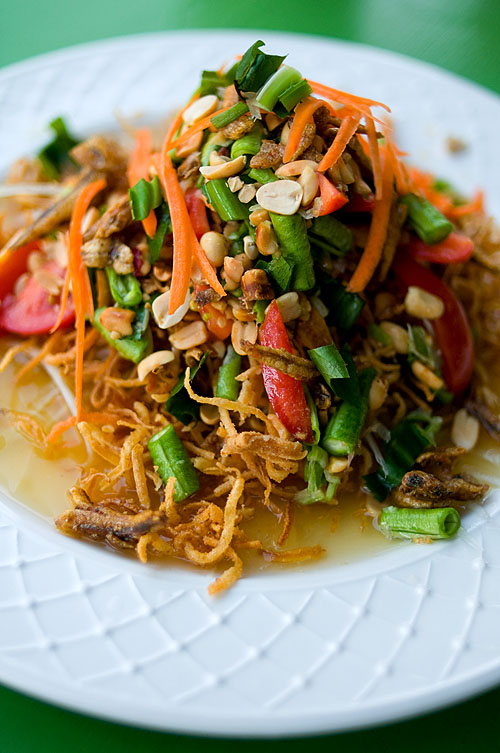 Som tam, green papaya salad, is probably the most popular dish in Thailand. The dish likely originates in northeastern Thailand, or perhaps Laos, but can now be found in virtually every corner of the country. It's equal parts cheap, spicy, quick and satisfying, leaving little wonder why it's become so popular.
Som tam, green papaya salad, is probably the most popular dish in Thailand. The dish likely originates in northeastern Thailand, or perhaps Laos, but can now be found in virtually every corner of the country. It's equal parts cheap, spicy, quick and satisfying, leaving little wonder why it's become so popular. This bowl of chicken khao soi was downed in the lovely city of Nan. The restaurant is located about a two-minute walk from Wat Phumin, my favourite Buddhist temple in Thailand. Wat Phumin's Buddhist murals, executed by a Thai Lue artist called Thit Buaphan in the late 19th century, are exquisite; this bowl of khao soi was merely acceptable. Sweet was the dominating flavour, if I remember correctly, although the dab of plain coconut cream was a welcome aesthetic flourish.
This bowl of chicken khao soi was downed in the lovely city of Nan. The restaurant is located about a two-minute walk from Wat Phumin, my favourite Buddhist temple in Thailand. Wat Phumin's Buddhist murals, executed by a Thai Lue artist called Thit Buaphan in the late 19th century, are exquisite; this bowl of khao soi was merely acceptable. Sweet was the dominating flavour, if I remember correctly, although the dab of plain coconut cream was a welcome aesthetic flourish. Nan, a little-visited city in northern Thailand, has a great atmosphere, an attractive setting, friendly people and some of the most beautiful temples in the country. Unfortunately, it also has one of the worst eating scenes of any city in Thailand.
Nan, a little-visited city in northern Thailand, has a great atmosphere, an attractive setting, friendly people and some of the most beautiful temples in the country. Unfortunately, it also has one of the worst eating scenes of any city in Thailand. Located almost exactly halfway between Chiang Saen and Sop Ruak ('The Golden Triangle'), Jinda's Kitchen claims to have been making northern-style dishes for 50 years. They have a small menu of only about six or eight items, one of which was, of course, khao soi. Her version was decent, a little on the bland side, I must admit, but her khanom jeen nam ngiaw (unfortunately I ate it before I remember to take a pic) was fantastic, probably among the best I've consumed. Either way, it's worth a stop, as there's little in the way of good food, particularly that of the local variety, in this corner of Chiang Rai.
Located almost exactly halfway between Chiang Saen and Sop Ruak ('The Golden Triangle'), Jinda's Kitchen claims to have been making northern-style dishes for 50 years. They have a small menu of only about six or eight items, one of which was, of course, khao soi. Her version was decent, a little on the bland side, I must admit, but her khanom jeen nam ngiaw (unfortunately I ate it before I remember to take a pic) was fantastic, probably among the best I've consumed. Either way, it's worth a stop, as there's little in the way of good food, particularly that of the local variety, in this corner of Chiang Rai. Andy Ricker, owner of
Andy Ricker, owner of  If you can read Thai, and spend enough time in northern Thailand, eventually you'll start to see the word luu on restaurant signs just about everywhere. I had a vague notion of this northern dish, knew it was something blood-related, and noticed that it always seemed to be found to be at restaurants that serve the famous northern-style laap. But other than this, I had never seen or sampled it. Recently in Phrae, I was able to get a crash course in luu.
If you can read Thai, and spend enough time in northern Thailand, eventually you'll start to see the word luu on restaurant signs just about everywhere. I had a vague notion of this northern dish, knew it was something blood-related, and noticed that it always seemed to be found to be at restaurants that serve the famous northern-style laap. But other than this, I had never seen or sampled it. Recently in Phrae, I was able to get a crash course in luu.

 If you'll allow me to backtrack a bit, I forgot to mention that I did eventually find a decent version of khao soi in Chiang Rai. Sold at the side of the street under two gigantic trees, Somkhuan Khao Soi does a pretty good bowl, his broth having the smokey flavour of chako, a dried spice that some vendors use in their curry paste mixture. Khanom jeen nam ngiaw is also available.
If you'll allow me to backtrack a bit, I forgot to mention that I did eventually find a decent version of khao soi in Chiang Rai. Sold at the side of the street under two gigantic trees, Somkhuan Khao Soi does a pretty good bowl, his broth having the smokey flavour of chako, a dried spice that some vendors use in their curry paste mixture. Khanom jeen nam ngiaw is also available. I didn't manage to find a whole lot of regional Thai food in the tiny riverfront town of Chiang Saen. Even the town's night market had the tired 'franchise' vendors selling the same dishes you'll find just about everywhere in Thailand nowadays. However the fact that cargo boats from Jinghong, in Yunnan province, dock at Chiang Saen meant that there were a couple interesting Chinese options. In particular, I had a great breakfast at Ah Ying, a family-run noodle joint located across the street from the Mekong River. I was pretty sure I was getting authentic Chinese-style noodles here because a) the entire family was speaking Chinese and b) the noodles were hand-pulled.
I didn't manage to find a whole lot of regional Thai food in the tiny riverfront town of Chiang Saen. Even the town's night market had the tired 'franchise' vendors selling the same dishes you'll find just about everywhere in Thailand nowadays. However the fact that cargo boats from Jinghong, in Yunnan province, dock at Chiang Saen meant that there were a couple interesting Chinese options. In particular, I had a great breakfast at Ah Ying, a family-run noodle joint located across the street from the Mekong River. I was pretty sure I was getting authentic Chinese-style noodles here because a) the entire family was speaking Chinese and b) the noodles were hand-pulled.
 This may look like just another bowl of beef khao soi, but they do things a bit differently at Khao Soi Islam, in Mae Sai. Rather than the typical yellow wheat and egg noodles, this version, which they call pa pa soi, employed thick noodles made from brown rice. The noodles were short and coarse, and had the texture and appearance of boiled taro, which is initially what I thought they were. Another interesting thing about this restaurant was that the owners, Thai Muslims of Chinese extraction, and staff communicated in a seemingly flawless mixture of Chinese, central Thai, northern Thai and Burmese.
This may look like just another bowl of beef khao soi, but they do things a bit differently at Khao Soi Islam, in Mae Sai. Rather than the typical yellow wheat and egg noodles, this version, which they call pa pa soi, employed thick noodles made from brown rice. The noodles were short and coarse, and had the texture and appearance of boiled taro, which is initially what I thought they were. Another interesting thing about this restaurant was that the owners, Thai Muslims of Chinese extraction, and staff communicated in a seemingly flawless mixture of Chinese, central Thai, northern Thai and Burmese. While in Mae Sai I decided to sneak over the border for breakfast in Burma. Specifically, I was looking forward to eating a bowl of mohinga, the thick fish broth and rice noodle dish that's often considered the unofficial national dish of that country. After a morning of wandering, I eventually found my mohinga, but not before running into several other interesting things.
While in Mae Sai I decided to sneak over the border for breakfast in Burma. Specifically, I was looking forward to eating a bowl of mohinga, the thick fish broth and rice noodle dish that's often considered the unofficial national dish of that country. After a morning of wandering, I eventually found my mohinga, but not before running into several other interesting things.





 Despite the amazing diversity of food in this country, much of the street food in Thailand is actually quite homogeneous; the same brand of bamee (wheat and egg noodles), Chai Sii, can be found in just about any town or city; central Thai dishes such as phat thai or phat sii iw are prepared at the farthest extremities of the country; and it's become the exception rather than the norm to find regional dishes at night markets. Luckily, when I was recently in Mae Sai, Thailand's northernmost town, I encountered the exception in khao soi noi, a Shan dish that, according to the incredibly detailed information on the cart (I didn't manage to read all of it), has its origins in neighbouring Chiang Saen district. Although the name might suggest the famous northern curry noodle dish, it's entirely different, and is probably more similar to
Despite the amazing diversity of food in this country, much of the street food in Thailand is actually quite homogeneous; the same brand of bamee (wheat and egg noodles), Chai Sii, can be found in just about any town or city; central Thai dishes such as phat thai or phat sii iw are prepared at the farthest extremities of the country; and it's become the exception rather than the norm to find regional dishes at night markets. Luckily, when I was recently in Mae Sai, Thailand's northernmost town, I encountered the exception in khao soi noi, a Shan dish that, according to the incredibly detailed information on the cart (I didn't manage to read all of it), has its origins in neighbouring Chiang Saen district. Although the name might suggest the famous northern curry noodle dish, it's entirely different, and is probably more similar to 


 Mae Salong is a remote hilltop community of Chinese immigrants in Chiang Rai province. The majority of people who live here are the descendants of KMT fighters who, after the communist victory in 1949, fled to Burma and then Thailand. Despite having been away from China for so long, their culture is still very strong, and you'll hear the Yunanese dialect of Chinese spoken much more than Thai (those who can speak Thai tend to do it with a funny Chinese accent). It goes without saying then that Chinese food, in particular dishes from Yunnan province, are also big here.
Mae Salong is a remote hilltop community of Chinese immigrants in Chiang Rai province. The majority of people who live here are the descendants of KMT fighters who, after the communist victory in 1949, fled to Burma and then Thailand. Despite having been away from China for so long, their culture is still very strong, and you'll hear the Yunanese dialect of Chinese spoken much more than Thai (those who can speak Thai tend to do it with a funny Chinese accent). It goes without saying then that Chinese food, in particular dishes from Yunnan province, are also big here.



 To my surprise, it was actually a bit of a struggle to find khao soi in Chiang Rai. This bowl is from Phor Jai, apparently one of the more famous khao soi joints in town, but I found it mediocre; the broth was quite bland and I'm not a big fan of this particular type of deep-fried noodle topping. The pickled veggies were good though, and some might like the fact that user-friendly diced chicken breast was used, rather than the typical chicken leg.
To my surprise, it was actually a bit of a struggle to find khao soi in Chiang Rai. This bowl is from Phor Jai, apparently one of the more famous khao soi joints in town, but I found it mediocre; the broth was quite bland and I'm not a big fan of this particular type of deep-fried noodle topping. The pickled veggies were good though, and some might like the fact that user-friendly diced chicken breast was used, rather than the typical chicken leg.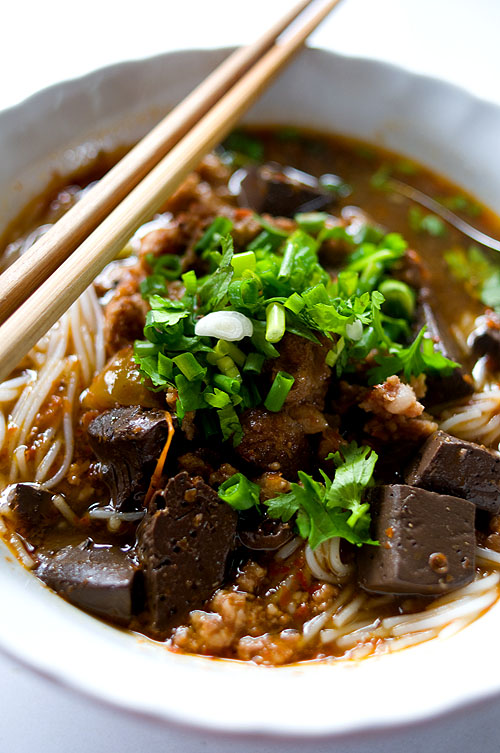 It's been far too long and I apologize. I've been working furiously on the next edition of Lonely Planet's Thailand, and simply haven't had the time to blog. I am in Chiang Rai at the moment, doing research for Thailand, and will do my best to share the food discoveries I've been making up here.
It's been far too long and I apologize. I've been working furiously on the next edition of Lonely Planet's Thailand, and simply haven't had the time to blog. I am in Chiang Rai at the moment, doing research for Thailand, and will do my best to share the food discoveries I've been making up here.

 After many, many visits to Bangkok's Chinatown in the last year, my seemingly aimless wanderings have culminated in this; beginning on December 6th, 15 of the images I captured there will be exhibited at Kathmandu, the Bangkok photography gallery owned by famed Thai photographer, Manit Sriwanichpoom. The official press release:
After many, many visits to Bangkok's Chinatown in the last year, my seemingly aimless wanderings have culminated in this; beginning on December 6th, 15 of the images I captured there will be exhibited at Kathmandu, the Bangkok photography gallery owned by famed Thai photographer, Manit Sriwanichpoom. The official press release: Jay is the Chinese/Thai word for vegetarian, and from now until October 9th is the annual Ngaan Jay, Vegetarian Festival. To be honest though, it is quite possibly the most innacurately-named festival around. Although everything for sale in Thailand's various Chinese districts during this period is entirely meat free, you'll actually find very few, if any, actual vegetables. Just about everything is either some form of starch (noodles, rice, potatoes) or protein (soy).
Jay is the Chinese/Thai word for vegetarian, and from now until October 9th is the annual Ngaan Jay, Vegetarian Festival. To be honest though, it is quite possibly the most innacurately-named festival around. Although everything for sale in Thailand's various Chinese districts during this period is entirely meat free, you'll actually find very few, if any, actual vegetables. Just about everything is either some form of starch (noodles, rice, potatoes) or protein (soy).





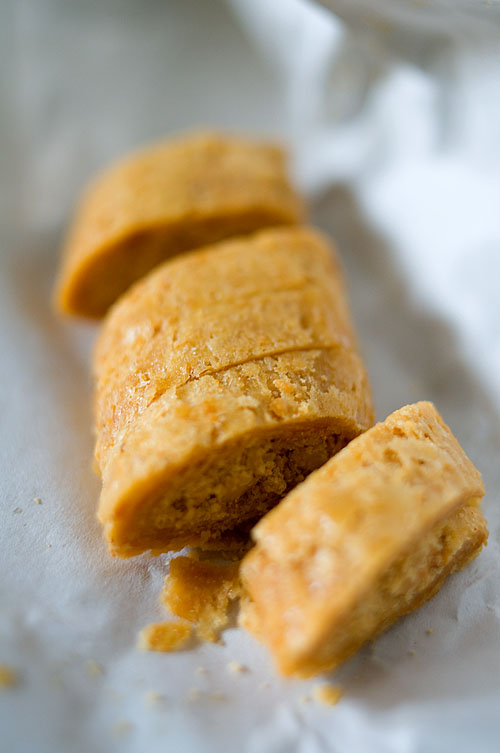 It's that time of year again: Thailand's annual Vegetarian Festival is in full swing, and as always, the best place to eat is the Chinatown area. Most people come for the various meat-free noodle and fried dishes, but I personally can't wait for khanom tup tap. This is an old-school snack made from peanuts, sugar and a bit of salt pounded into a flaky roll--via a pretty amazing process.
It's that time of year again: Thailand's annual Vegetarian Festival is in full swing, and as always, the best place to eat is the Chinatown area. Most people come for the various meat-free noodle and fried dishes, but I personally can't wait for khanom tup tap. This is an old-school snack made from peanuts, sugar and a bit of salt pounded into a flaky roll--via a pretty amazing process.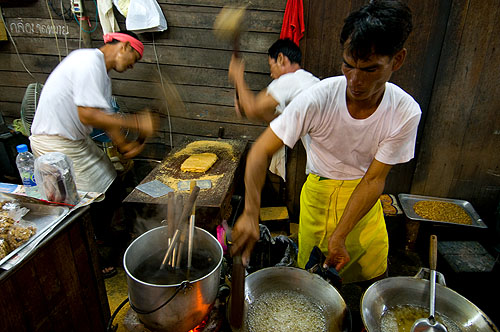
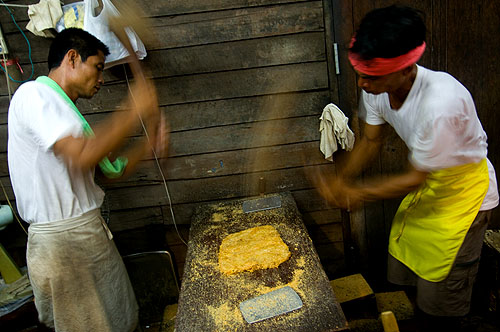
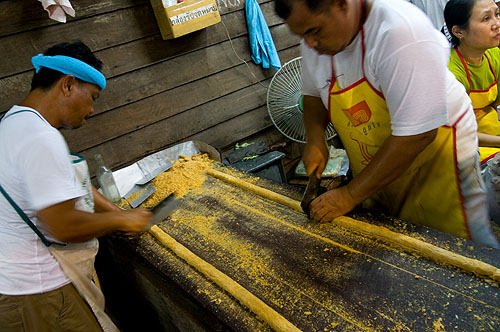
 Kuay jap, a thick broth with deep-fried crispy pork, pork offal and thick noodles is not a dish I thought I would like. In general, I try to keep my meat consumption to a minium, and I like noodles well enough, but rarely crave them. However with kuay jap it's the broth that keeps drawing me back... The thick liquid is so laden with pepper that it's positively spicy.
Kuay jap, a thick broth with deep-fried crispy pork, pork offal and thick noodles is not a dish I thought I would like. In general, I try to keep my meat consumption to a minium, and I like noodles well enough, but rarely crave them. However with kuay jap it's the broth that keeps drawing me back... The thick liquid is so laden with pepper that it's positively spicy.